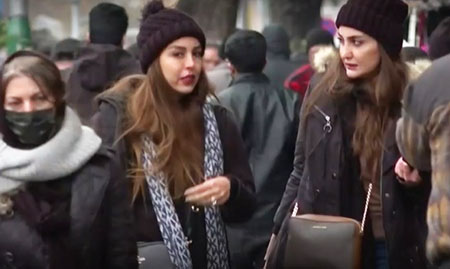by WorldTribune Staff, December 12, 2022
The ruling clerics’ decades-long effort to ensure Iran stays on a strict Islamic path is facing its greatest threat yet as protests against the regime which call for more freedom continue nationwide.
Though they risk the full force of the law, the protests in Iran “against the core values underpinning the Islamic system suggest the country might be heading the other way,” the Wall Street Journal noted in a Dec. 11 analysis.

The protests erupted in mid-September after 22-year-old Mahsa Amini died in police custody after she was arrested for allegedly violating Iran’s strict dress code.
Acts of what the regime considers anti-Islamic behavior are on the rise, including:
• Thousands of women now walk around the streets of Teheran without the mandatory hijab, or headscarf.
• Young Iranians have been filmed knocking turbans off clerics’ heads, with the footage posted online.
• Teenage girls share videos of each other stomping on pictures of the founder of the Islamic Republic, Ayatollah Ruhollah Khomenei, and his successor, Supreme Leader Ali Khamenei.
Those protesting for more freedoms, many of whom are calling for the end to the Islamic Republic itself, do so at at great risk but they also pose one of the biggest challenges to Iran’s establishment since the 1979 revolution that brought the clerics to power.
“It is a secular turn that has long been under way,” the Journal noted. “In the years leading up to the current protests, young Iranian men and women gathered freely together in Tehran coffee shops, defying conservative Islamic norms. Affluent city dwellers kept houses on the shore of the Caspian Sea, where unrelated men and women vacationed together. For an elite few, drugs, alcohol and miniskirts — all illegal — were regular features at house parties.”
A 2020 survey by Iranian researchers with the Netherlands-based GAMAAN research foundation showed more than 30% of Iranians identified as nonreligious or atheist — about the same proportion who said they followed the state religion of Shiite Islam.
A survey by the Iranian Parliament’s research center in 2018 showed support for the hijab had fallen from around 85% in the early 1980s to 35%.
“Iranian society by every measure is now more secular, decidedly anti-religion, decidedly anticlerical than it ever was,” said Abbas Milani, a professor and expert on Iranian culture at Stanford University.
Khamenei, the final authority in Iran’s Islamic system, has accused Western powers of orchestrating the protests.
Iranian authorities seek to influence Iranians in nearly every aspect of their lives. The paramilitary Basij militia, which is best known for upholding domestic security and suppressing unrest, began focusing more on cultural threats and making sure people were given correct religious instruction.
Iran has spent $300 million to set up and run dozens of educational centers to promote conservative Islamic teachings, according to Iranian media reports. It also established Revolutionary Guard units in all 31 provinces to instill the Islamic Republic’s revolutionary ideals from kindergarten all the way up to university.
The regime not only encourages Iranians to have more children but also offers cheap fertility treatment and the additional incentive of free shares in the stock market valued at up to 15 million rials, equivalent to around $41. Parents are able to retire a year earlier with each child they have. After having a third child, couples are offered $5,000 in housing loans to be repaid in 20 years.
Military commanders, meanwhile, call on female Revolutionary Guard members to be “pioneers” and have at least five children. State media has made a minor celebrity out of a cleric called Mohammad Muslim Mafi who encourages Iranians to have as many children as possible. His wife has given birth to 13.
But, the Journal notes, a “growing cohort of Iranians is immune to this kind of messaging” with many considering whether to get married at all.
The Journal cited the case of Faezeh, a 40-year-old teacher in Teheran, who has lived with her romantic partner for two years without getting married — an illegal but growing trend known as a “white marriage.” Cohabiting without getting hitched avoids the potentially crippling expense of a wedding, makes it easier for women to separate from their partners and lessens family pressure to have children.
“I want to continue living in Iran, and I don’t see a very good future for a kid here,” said Faezeh, who says she has chosen not to have children because of global warming, Islamic indoctrination in Iranian schools and the country’s poor outlook.
Some demonstrators are even willing to defy their own parents by taking to the streets. One 30-year-old described how his mother once threatened to call the police on him when she caught him preparing to leave the house for a rally.
“The Islamic Republic had brainwashed her to such an extent that a mother was ready to call the police on her child,” he said. “That day was a turning point that made me want to fight this filthy regime until my very last breath.”
No facet of modern Iran appears untouched by this growing culture war.
“Authorities have cracked down on pet ownership, issuing fines to dog walkers and encouraging residents to snitch on their pooch-owning neighbors. In July, hundreds of dogs, which are considered unclean in Islam, were shot and buried in a landfill north of Teheran,” the Journal noted.
Action . . . . Intelligence . . . . Publish
